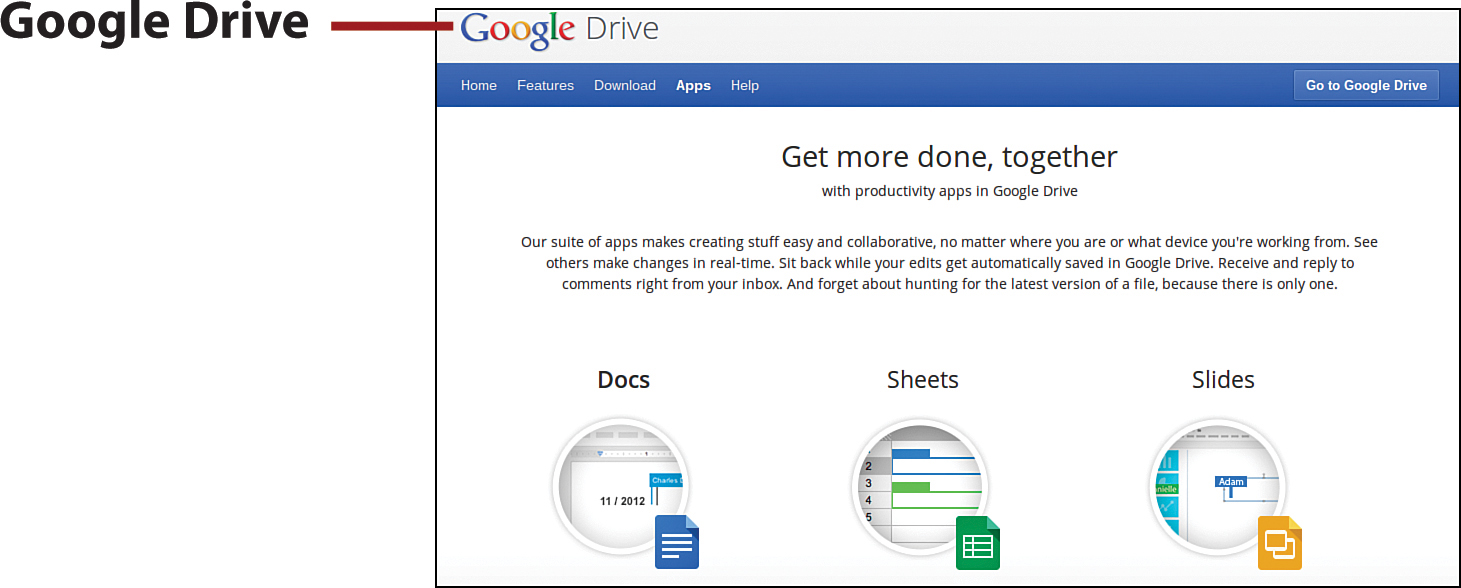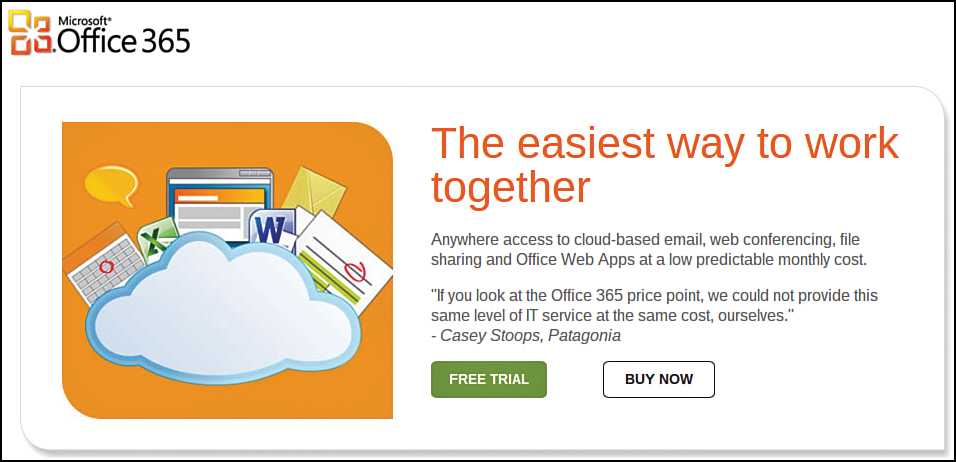12. Working in the Cloud
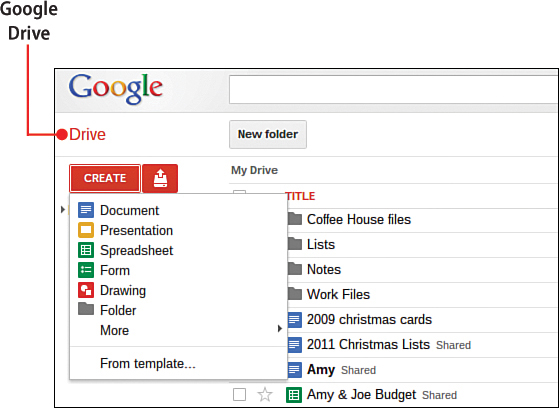
In this chapter, you learn about web-based alternatives to traditional desktop applications.
If you’re used to using a traditional Windows or Mac computer, you’re probably used to using specific software programs. Well, none of those programs work on your new Chromebook; Chromebooks don’t run any traditional software, if you recall.
So how do you do what you used to do now that you have a new Chromebook? It’s all a matter of finding web-based alternatives to traditional software programs—of which there are many.
Office Suites in the Cloud
The most popular productivity software program today is Microsoft Office, with its combination of word processing (Word), spreadsheet (Excel), and presentation (PowerPoint) functionality. Since you probably use Office either at work or at home (or both), you need a web-based alternative to this traditional desktop software suite. There are several to choose from.
The most popular of these cloud productivity suites come from Google, Zoho, and—believe it or not—Microsoft. Of these suites, Google Drive has the largest installed base today; many companies, organizations, and educational institutions have already switched from Microsoft Office to Google’s free web-based applications. But don’t rule out any of the competing suites, especially Microsoft’s Office Web Apps and Office Live 365; the latter, despite its higher cost, will have enormous appeal to corporations currently running Office software.
Which of these suites is best for your own use? It depends on what you want. If compatibility with existing Microsoft Office software is your prime concern, you can’t go wrong with Microsoft’s Office Web Apps or Office 365. The former is free and good for basic editing; the latter costs money but provides more complete Office functionality. If collaboration is your focus, Google Drive can’t be beat. In terms of ease of use, especially in file management, both Google Drive and Zoho Office do a great job. I’ll also give Google Drive the lead in speed; it’s a pretty zippy suite of apps, compared to the competition.
Bottom line, if you’re looking for office productivity online, you need to check out all the major players. There are pluses and minuses to each, but you’re sure to find one that best suits the way you like to work.
Google Drive
Google Drive (drive.google.com) is not only Google’s online storage service, it’s also a web-based office suite. As you might suspect, Google Drive (formerly known as Google Docs) works very well with Google’s Chrome OS and Chromebooks. It also integrates seamlessly with Google’s other apps and services; if you choose Google, you get kind of a one-stop-shop for all your Chromebook computing needs.
The Google Drive suite contains three separate applications, which are covered in more depth later in this chapter:
• Docs (word processor)
• Sheets (spreadsheets)
• Slides (presentations)
Forms and Drawing
Google Drive also includes Forms and Drawing apps, but those aren’t really traditional office applications.
File management for all three apps is integrated into your Google Drive account. When you access your Google Drive from Chrome’s File Manager, you see all your word processing, spreadsheet, and presentation files in one place. For full functionality, you have to log onto Google Drive (drive.google.com) from the Chrome browser; from this web-based Google Drive dashboard, you can create new documents, open existing ones, and even import documents from Microsoft Word, Excel, and PowerPoint. The Google Drive web dashboard looks a little like the Gmail inbox, and works pretty much the same way.
Google Drive is probably the best of all web-based suites for sharing and collaboration. Online file sharing is one of Google’s overall strengths, of course; if you plan on collaborating online on group projects, Google Drive is the way to go.
Another big advantage of the Google Drive suite is that it’s free. There’s no one-time fee or ongoing subscription fee; you log on with your Google Account and you’re ready to go.
Google Apps
Although Google Drive is free for individuals to use, Google does offer a paid version of the suite, dubbed Google Apps, designed specifically for corporations and other large institutions. This paid version is essentially the same as the free Google Drive, but with enhanced storage and support for information technology (IT) departments. (There’s also a version of Google Apps for Education, which many colleges use.)
Microsoft Office Web Apps
When Google jumped out into an early lead in the market for web-based productivity suites, you couldn’t expect Microsoft to stand by idle. It took a little time, but Microsoft eventually came out with a web-based version of Microsoft Office, dubbed Office Web Apps. This cloud productivity suite includes web-based versions of the primary Office apps:
• Microsoft Word Online (word processing)
• Microsoft Excel Online (spreadsheets)
• Microsoft PowerPoint Online (presentations)
• Microsoft OneNote Online (note-gathering and information sharing)
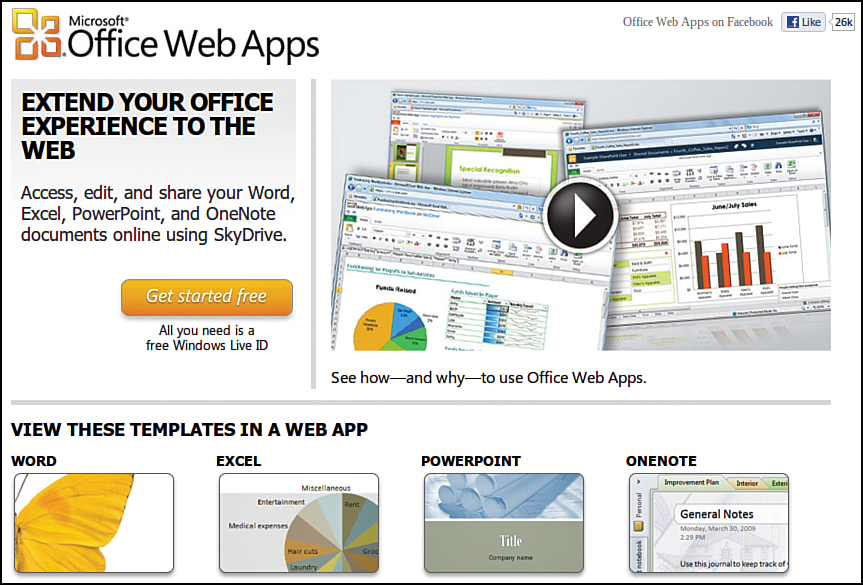
If you need full compatibility with your existing Office documents then Office Web Apps is your web-based productivity suite of choice. A Word document is a Word document is a Word document, whether you’re editing in the software-based version of Word or the online version of the app. Conversion errors are few and far between.
In addition, Office Web Apps contain much of the same functionality as the software version of Microsoft Office. (Most, but not all; some sacrifices have been made for online use.) Still, it’s a fairly seamless transition from Microsoft Office software to Office Web Apps.
The consumer version of Office Web Apps is part of Microsoft’s SkyDrive cloud-based storage solution, located at office.microsoft.com/web-apps/. It’s free for consumer use.
Microsoft Office 365
Microsoft Office Web Apps are also available to small and medium-sized businesses via the Office 365 service. Office 365 consists of the three basic Office apps plus additional applications:
• Microsoft Word Online
• Microsoft Excel Online
• Microsoft PowerPoint Online
• Microsoft OneNote Online
• Microsoft Outlook Online (email/scheduling)
• Microsoft Publisher Online (desktop publishing)
• Microsoft Access Online (database management)
• Microsoft InfoPath Online (form design/management)
• Microsoft Exchange Online (messaging/personal information management)
• Microsoft SharePoint Online (collaboration and sharing)
• Microsoft Lync Online (instant messaging and web conferencing)
Microsoft also offers a Home Premium version of Office 365, available for a $99.99 per-year subscription. This version includes the Word, Excel, PowerPoint, Outlook, OneNote, Access, and Publisher online apps. If you absolutely, positively need to use the full version of Office, it’s worth considering—even if it’s on the pricey side. Learn more at www.microsoft.com/office365/.
Zoho Docs
The other major player in web-based productivity suites is Zoho Docs. Zoho’s individual word processing, spreadsheet, and presentation offerings are every bit the equal of those in Google Drive. Also like Google Drive, Zoho features impressive sharing and collaboration features, including a proprietary instant chat feature.
Zoho Docs includes the following applications:
• Zoho Writer (word processing)
• Zoho Sheets (spreadsheets)
• Zoho Show (presentations)
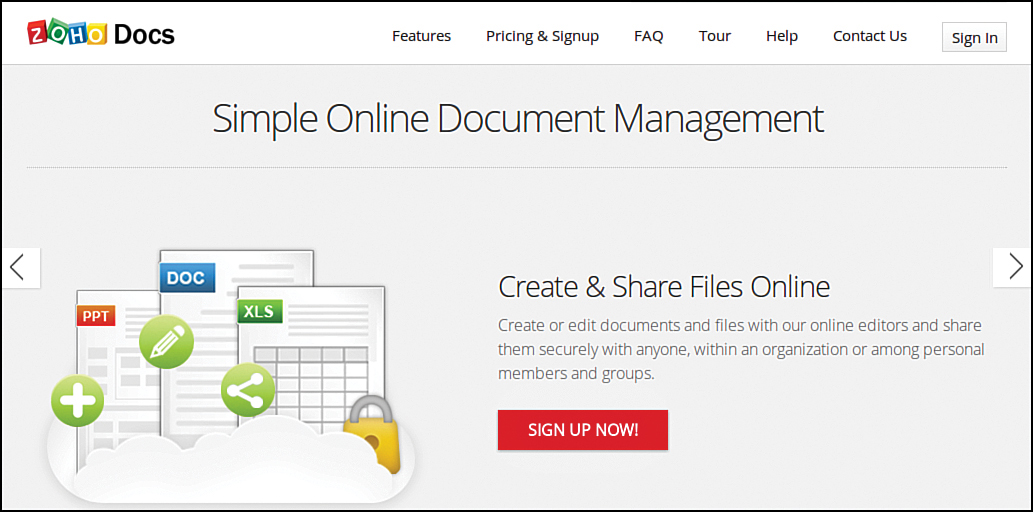
Zoho was one of the first companies in the web-based application space. As such, the company claims a fairly large and loyal user base, with more than 4 million users of its web-based applications.
Zoho Docs is free for personal use. Business users might need to sign up for Zoho’s subscription versions, which runs $3 to $5 per month per user. (Volume discounts are available.) Learn more at www.zoho.com/docs/.
Word Processing in the Cloud
Big productivity suites aside, let’s look a bit at the individual apps available, starting with word processing. Just about everyone who uses a computer uses a word processing program—most likely, some version of Microsoft Word. People use Word to do almost any type of writing, from memos and thank-you notes to big reports and newsletters.
You need to find some alternative to Word, then, if you want to be productive with your Chromebook. Not surprisingly, the top three cloud word processing apps come from Google, Microsoft, and Zoho.
Google Docs
Google Docs (drive.google.com) is the most popular web-based word processor available today. Like all things Google, the Google Docs interface is clean and, most important, it works well without imposing a steep learning curve. Basic formatting is easy enough to do, storage space for your documents is generous, and sharing/collaboration version control are a snap to do.
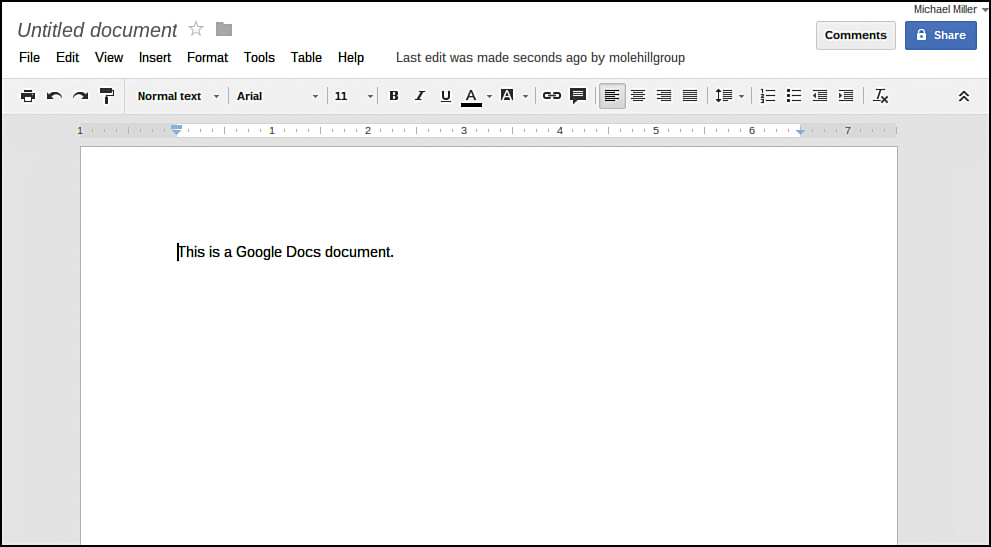
The Docs word processor looks a lot like Microsoft Word—or at least an older version of Word, before it went to the “ribbon” interface. You have a big blank space to create your document, a pull-down menu bar, and a toolbar with common commands. It’s pretty familiar looking and fairly easy to use.
That said, Google Docs doesn’t include all the functionality you’re used to in Microsoft Word. In particular, Docs lacks some of Word’s more sophisticated document formatting. But Google Docs is a decent replacement for Word if your needs are fairly traditional; it should do for the majority of everyday users. And, like all Google apps, Google Docs is free.
Microsoft Word Web App
The web-based version of Microsoft Word is the Word Web App (office.microsoft.com/web-apps/). The Word Web App looks and feels pretty much like the desktop version of Word, which shouldn’t be surprising.
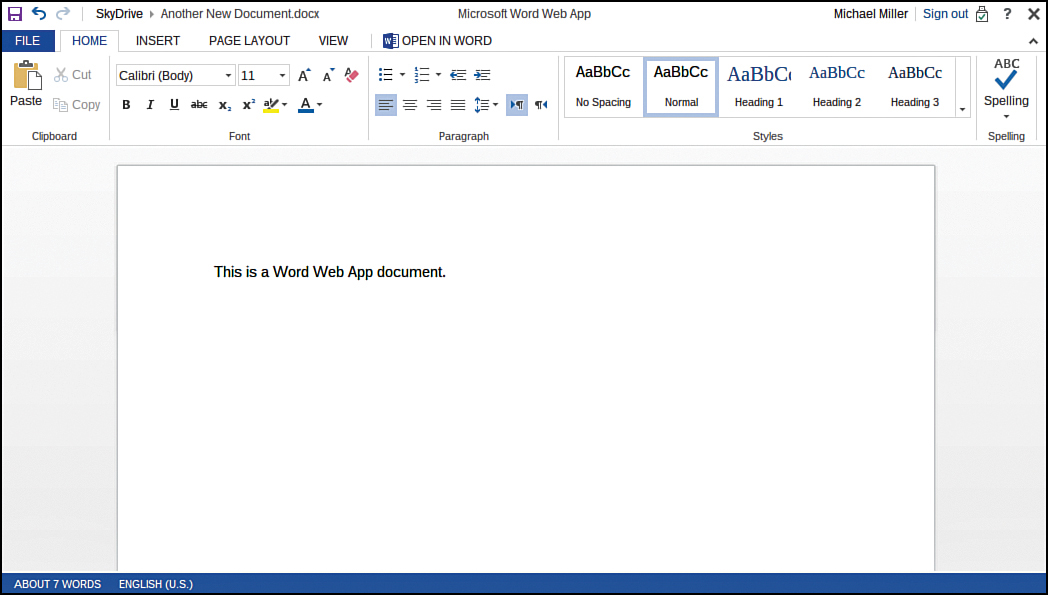
Obviously, the Word Web App is the app of choice if you want to maintain full compatibility with desktop versions of Word. It’s also free for personal use; businesses should look into a subscription to Office Live 365, which includes the Word Web App.
Zoho Writer
As previously noted, Zoho’s web-based applications are right up there with Google in terms of functionality and features, and this is especially true of Zoho Writer. This app easily holds its own against, if not surpasses, Google Drive in the web-based word processor race.
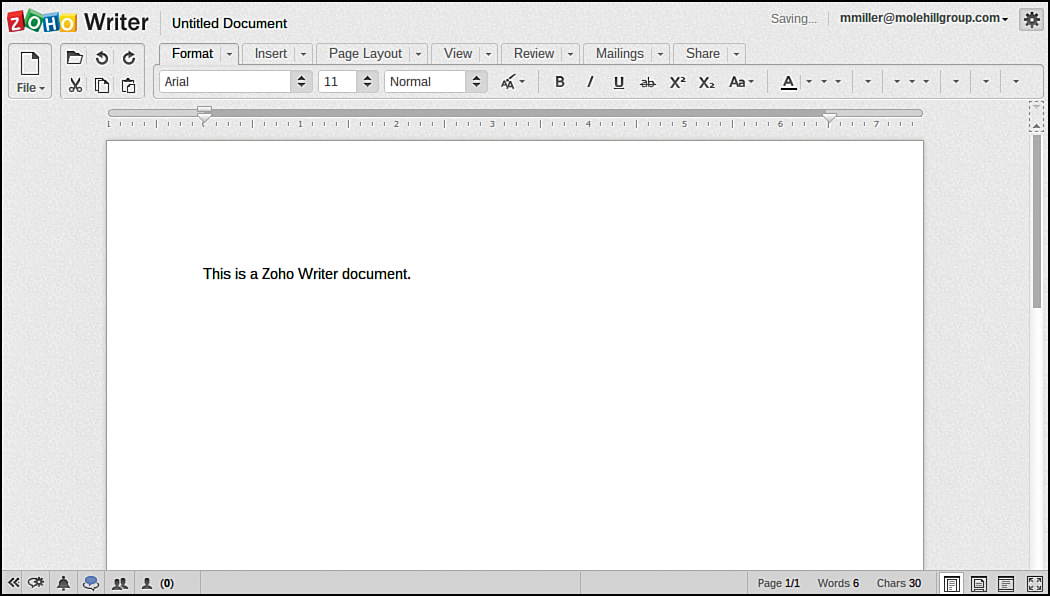
Zoho Writer (www.zoho.com/docs/) displays multiple documents in a single window, thanks to the app’s tabbed interface. You get all the standard editing and formatting features, as well as page numbering, headers and footers, footnotes and endnotes, tables of contents, and other advanced features not found in all other web-based word processors.
Like Google Drive, Zoho Writer is a free application.
Spreadsheets in the Cloud
If the word processor is the most-used office application, then the spreadsheet is the second most-important app. Office users and home users alike use spreadsheets to prepare budgets, create expense reports, perform “what if?” analyses, and otherwise crunch their numbers.
There are several web-based spreadsheet applications that are worthy competitors to Microsoft’s Excel software. As with word processors, the big three spreadsheet apps come from Google, Microsoft, and Zoho.
Google Sheets
Google Sheets (formerly known as Google Spreadsheets) was Google’s first application in the Google Drive suite. (It’s also the only app in the suite that Google developed in-house.) As befits its longevity, Google Sheets is Google’s most sophisticated web-based application.
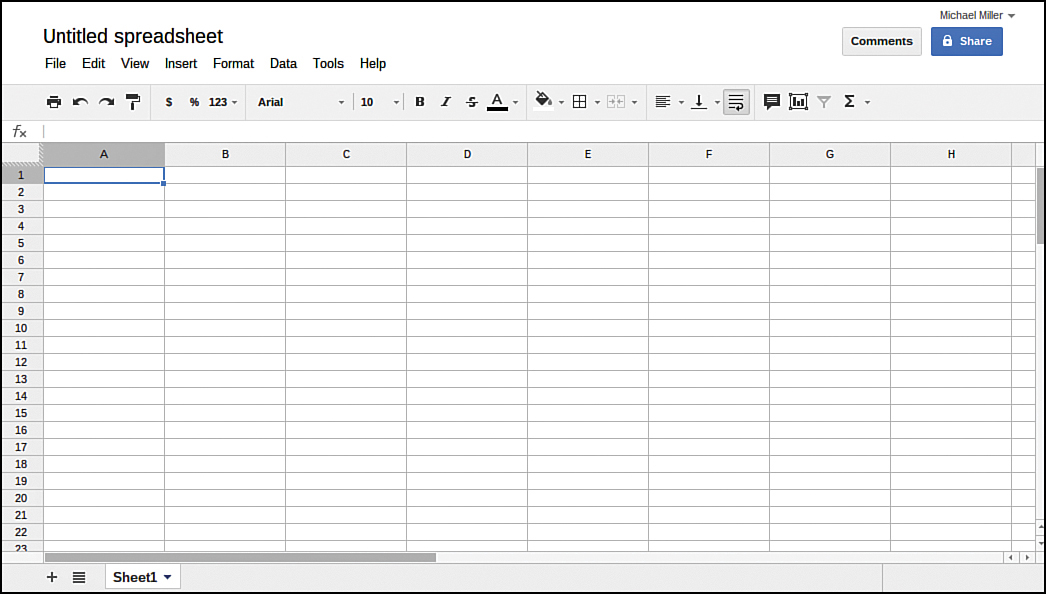
You access Google Sheets from the main Google Drive dashboard (drive.google.com). The Sheets workspace looks a lot like every other PC-based spreadsheet application you’ve ever used, whether you started with VisiCalc, 1-2-3, Quattro Pro, or Excel. You’ll quickly recognize the familiar row-and-column grid; sure, the buttons or links for some specific operations might be in slightly different locations, but pretty much everything you expect to find is somewhere on the page.
In daily use, you’ll find that Google Sheets is one of the most fully featured web-based spreadsheet applications available today, matching Excel almost feature to feature. It includes all the big features, including formulas and functions, charts, and even pivot tables. It’s a worthwhile alternative to the Excel program—and it’s completely free.
Microsoft Excel Web App
Of course, when it comes to alternatives to Microsoft Excel software, you definitely have to consider Microsoft’s Excel Web App (office.microsoft.com/web-apps/). This app is essentially Excel on the Web, with many (but not all) of the same features available. As you might suspect, it looks and feels much like the desktop version of Excel; there’s full file compatibility, as well.
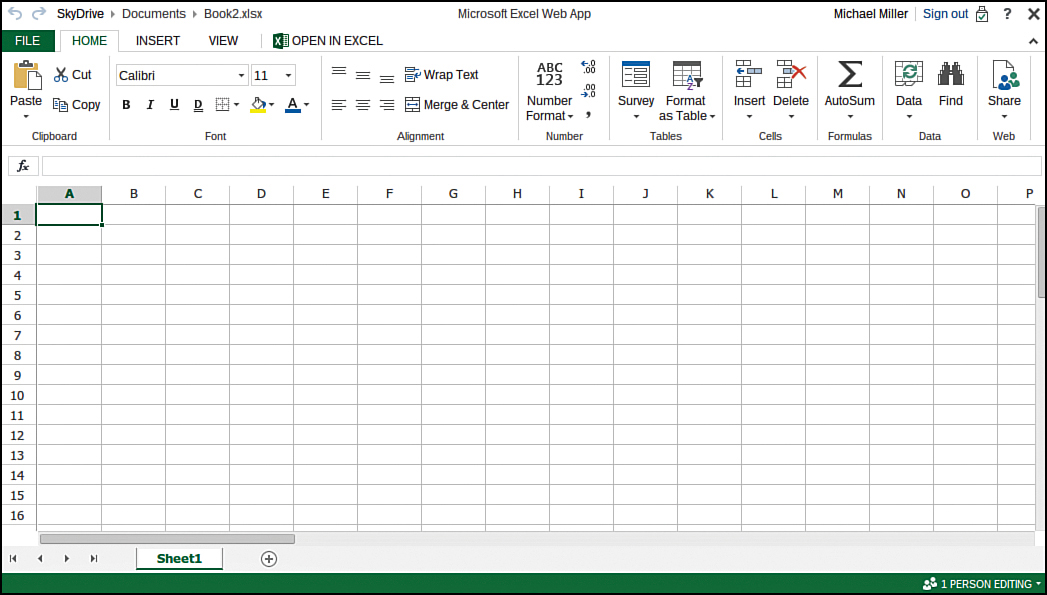
Like other Office Web Apps, the Excel Web App is free for personal use; businesses should look into a subscription to Office Live 365, which includes the Word Web App.
Zoho Sheet
Zoho Sheet (www.zoho.com/docs/) is Zoho’s web-based spreadsheet application. Like all Zoho apps, this one is fully featured with great sharing and collaboration features.
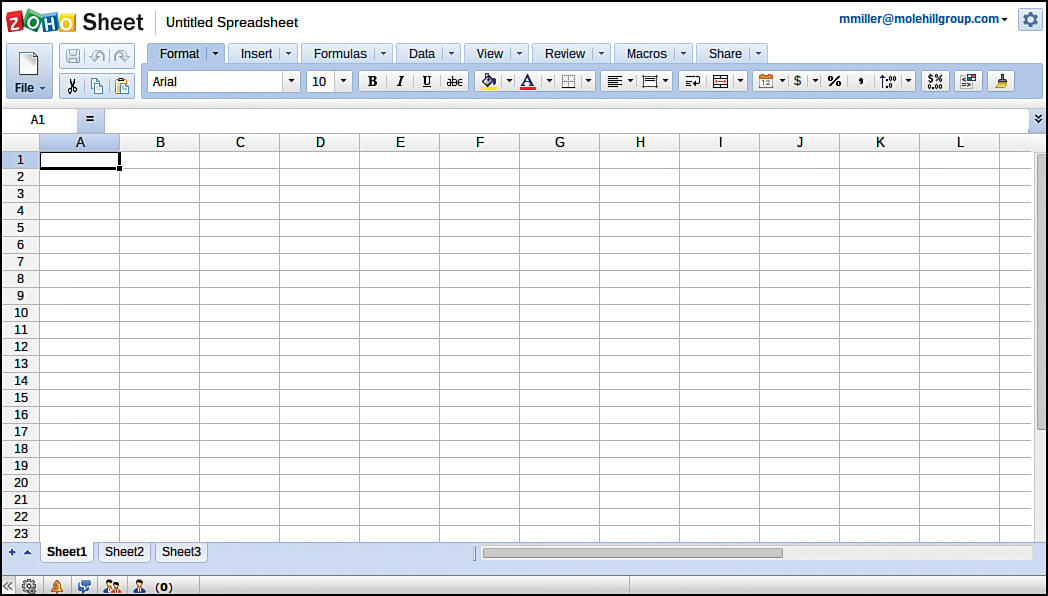
You get an Excel-like toolbar-based interface, multiple sheets in each file, a full load of functions, lots of different types of graphs, and all the formatting options you need to create great-looking printouts. Just as useful, Zoho Sheet lets you publish your web spreadsheets to your own website or blog; it’s a simple one-button operation.
In short, Zoho Sheets is a leader in terms of features and functionality. It’s definitely worth considering—especially at the price. (It’s free.)
Presentations in the Cloud
One of the last components of the traditional office suite to move into the cloud is the presentation application. Microsoft PowerPoint has ruled the desktop forever, and it’s proven difficult to offer competitive functionality in a web-based application; if nothing else, slides with large graphics are slow to access online in an efficient manner.
That said, there is a new crop of web-based presentation applications that aim to give PowerPoint a run for its money. The big players, as might be expected, are Google, Microsoft, and Zoho, but there are several other applications that are worth considering if you need to take your presentations with you on the road—or collaborate with users in other locations.
Google Slides
Google Slides, formerly known as Google Presentations, is the latest addition to the Google Drive suite of apps. It’s meant to compete with Microsoft PowerPoint—although it lacks some of that program’s features and functionality.
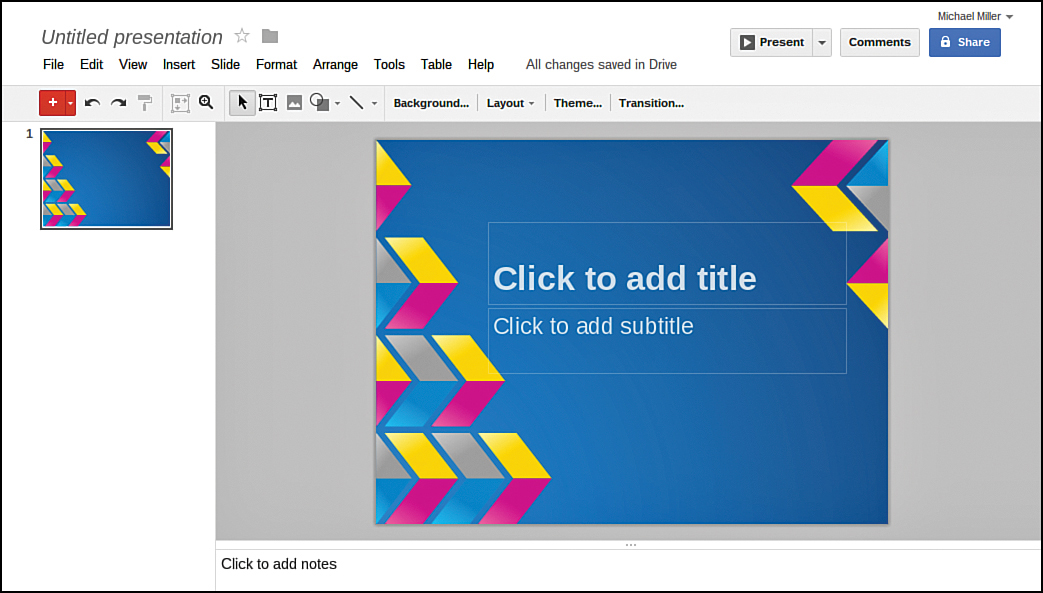
New and existing presentations are created and accessed from the main Google Drive dashboard (drive.google.com). The Sheets interface looks a lot like pre-2007 versions of PowerPoint, but with a few things missing. In particular, although you can include text, images, and shapes on a slide, there’s no chart-making facility.
What you do get is the ability to add title, text, and blank slides; a PowerPoint-like slide sorter pane; a selection of predesigned themes; the ability to publish your file to the Web or export as a PowerPoint PPT or Adobe PDF file; and quick and easy sharing and collaboration, the same as with Google’s other web-based apps.
If you use the other Google Drive apps, Sheets should be a natural choice. However, the lack of advanced presentation features might cause power PowerPoint users to look elsewhere for their online presentation needs.
Microsoft PowerPoint Web App
Desktop PowerPoint users will be right at home with Microsoft’s PowerPoint Web App. That said, it suffers from some of the same limitations as do other web-based presentation apps—no slide transitions, no tables, no charts, and so forth. So although PowerPoint Web App looks and feels like the desktop version of PowerPoint, it’s functionality is much less than what even casual users are used to.
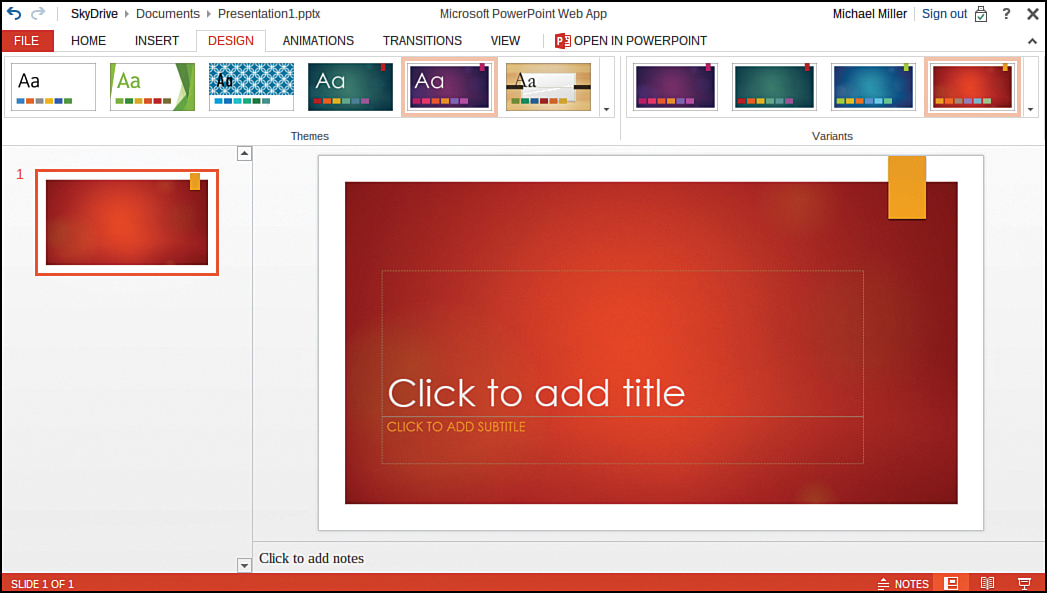
You do get fairly good compatibility with regular PowerPoint files, though, limited functionality excepted. And it’s free—at least to personal users. (Businesses should consider subscribing to Office Live 365 instead.)
Zoho Show
Zoho Show (www.zoho.com/docs/) is probably the weakest link in the Zoho Office suite. Like Google Presentations, Zoho Office enables you to create good-looking text-based slides, but that’s about all. As with competing presentation apps, there is no charting function, no tables, and no slide transition effects.

That said, Zoho Show integrates well with Zoho’s other web-based applications, and offers easy sharing and collaboration. So if you want a good basic presentation with few bells or whistles, it’s worth checking out.
Other Presentation Apps
Presentations is one area where the big three don’t have as big a lead as they do in other types of apps. That means you might want to check out some of the other popular web-based presentation apps, including Empressr (www.empressr.com) and SlideRocket (www.sliderocket.com).
Photo Editing in the Cloud
If you take a lot of pictures with your digital camera, you’re used to touching up those photos with Adobe Photoshop Elements or some similar photo editing program. Obviously, you can’t install a photo editing program on your Chromebook; instead, you have to do your photo editing online.
What can you do with an web-based photo editing app? Although you don’t have quite the number of options you do with most desktop photo editing software, you do get all the basics. You can crop and rotate your photos, color correct them, fix the red eye effect, adjust contrast and brightness, and maybe even combine multiple photos into a photo collage.
Most of these cloud applications work by having you first upload your photo to the editing site. You then apply the edits you want, often by clicking a “quick fix” button of some sort. Your edited photo is then downloaded back to your Chromebook (or to your Chromebook’s external storage) for archiving.
Adobe Photoshop Express Editor
This first web-based photo editing application is also arguably the best. Adobe Photoshop Express Editor (www.photoshop.com/tools/expresseditor/) certainly has a stellar lineage, coming from the same company that brings you Photoshop CS, the number-one photo editing program for serious photographers. As the name implies, Photoshop Express Editor is kind of a quick and dirty version of the full-featured Photoshop CS, with all the basic editing controls you need to fix the most common photo problems. And, best of all, it’s completely free to use.
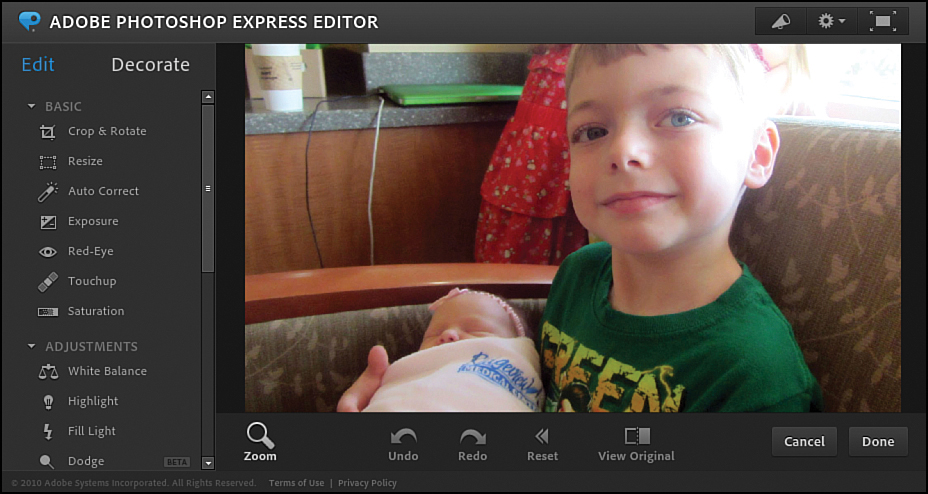
Photoshop Express Editor offers far and away the largest collection of editing/enhancement options of any online photo editor. Suffice to say, just about anything that’s wrong with a photo, you can fix online with Photoshop Express.
Adobe lets you store up to 2GB of photos at any time. And, like many other web-based photo editors, Photoshop Express Editor is integrated with Flickr, so you can upload your edited photos to the Flickr site with a minimum of fuss and muss.
Other Online Photo Editors
Although Adobe’s Photoshop Express Editor is an impressive (and free) service, there are several other free online photo editors worth checking out. These include the following:
• FotoFlexer (www.fotoflexer.com)
• PicMonkey (www.picmonkey.com)
• Picture2Life (www.picture2life.com)
• Pixlr (www.pixlr.com)
Finances and Banking in the Cloud
Users seem to be of two minds when it comes to handling their personal finances. Either you use your bank’s website to handle all your transactions, or you use a financial program like Quicken.
If you’re of the former persuasion, nothing changes with your Chromebook. You should still be able to access your bank’s website and do all your banking from there.
If you’re a Quicken user, however, you need to change the way you do things, as there’s no web-based version of that traditional desktop program. That means you need to switch to using your bank’s website, or go with Mint (www.mint.com), the leading web-based financial management program.
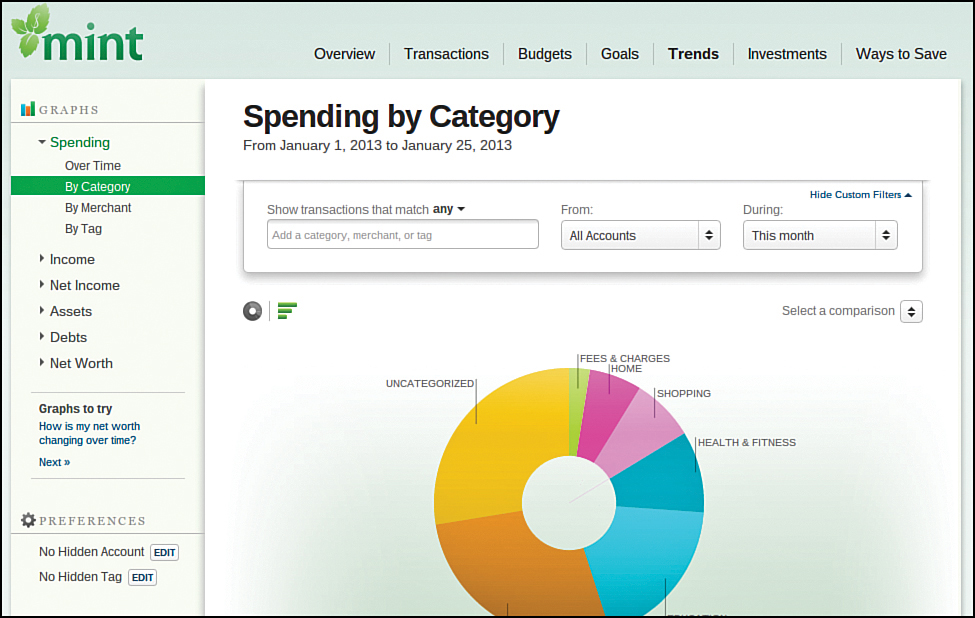
Actually, moving to Mint shouldn’t be too tough for Quicken users, as they’re both owned by the same company (Intuit). Unlike the increasingly expensive Quicken program, Mint is a free app, and works in much the same fashion. Although I’d never call moving all your financial information from one platform to another a simple process, this is probably as easy as it gets.
If you run your own business, you probably use QuickBooks for your accounting needs. Fortunately, Intuit has an online version of QuickBooks that offers much of the same functionality as the desktop version. Learn more at quickbooks online.intuit.com.
Calendars in the Cloud
Most computer users today have embraced keeping their schedules on their PCs. Not that the old-fashioned wall-hanging calendar is dead, it’s just that it’s a whole lot easier to track appointments and events electronically; the computer does all the busywork for you.
It’s even better when you use a cloud calendar app. A web-based calendar service stores your calendars on the Internet, where they can be accessed from any computer that has an Internet connection. This lets you check your schedule when you’re on the road, even if your assistant in the office or your spouse at home has added new appointments since you left. Web-based calendars are also extremely easy to share with other users in any location, which make them great for collaborative projects.
Google Calendar
The most popular web-based calendar today, no doubt due to its association with the Web’s most-used search engine, is Google Calendar (calendar.google.com). Google Calendar is free, full-featured, and easy to use. It lets you create both personal and shared calendars, which makes it ideal for tracking business group, family, and community schedules.
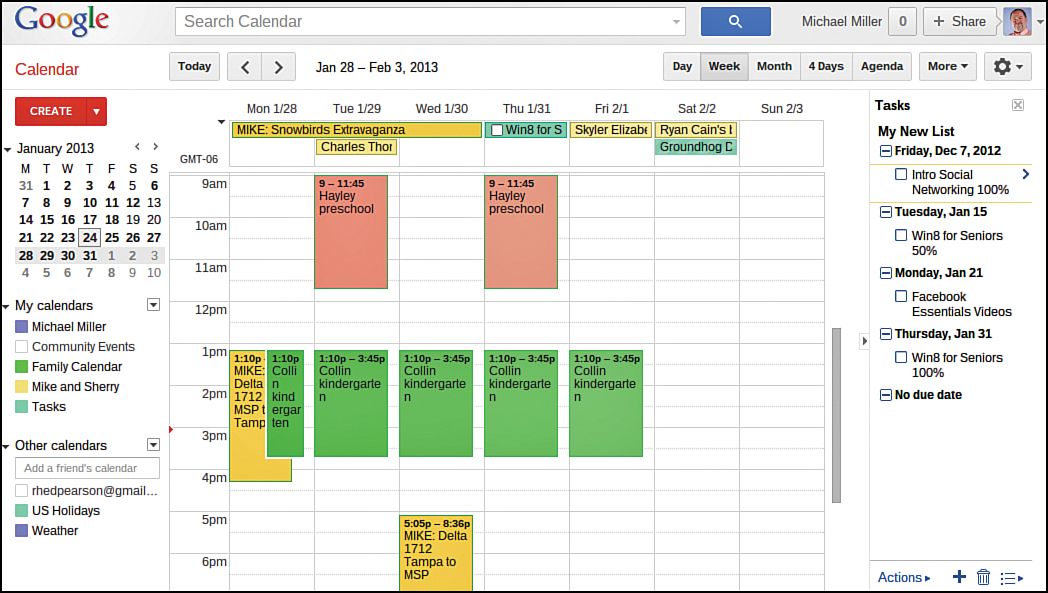
Google Calendar looks pretty much like every other calendar you’ve ever seen. You enter your appointments (which Google calls “events”) directly into the calendar, which you can display in either daily, weekly, or monthly views. You can also, if you like, view your weekly agenda on a single page.
Because Google Calendar is web-based, you can use it to create not only a private calendar for yourself, but also public calendars for your company or organization. Create a public calendar and all employees or attendees can access it via the Web. In addition, special event invitation features make it easy to invite others to an event—public or private.
Other Online Calendars
Most online calendars function similarly to Google Calendar, letting you schedule meetings and appointments, and often tracking tasks in to-do lists, too. Some popular alternatives include the following:
• Cozi Family Organizer (www.cozi.com)
• Hotmail Calendar (calendar.live.com)
• Yahoo! Calendar (calendar.yahoo.com)
• Zoho Calendar (www.zoho.com/calendar/)
Email in the Cloud
Traditional email is anything but cloud-based. The type of email program installed on most Windows and Mac computers uses a protocol called the Post Office Protocol (POP). POP email requires the use of a dedicated email client program, such as Microsoft Outlook, and—at the Internet Service Provider (ISP) level—separate email servers to send and receive messages.
Fortunately, there are cloud alternatives, in the form of web-based email services, also known as web mail or HTTP email. Unlike POP email, web mail can be accessed from any computer (including your Chromebook) using any web browser, and all your messages are stored on the Web, not locally. This lets you retrieve and manage your email when you’re out of the office or on the road.
The three largest web mail services today are hosted by Google, Microsoft, and Yahoo!
Gmail
Google’s web mail service is called Gmail (mail.google.com). Like most other web mail services, Gmail is completely web-based, works great with your Chromebook, and can be accessed from any computer or device with an Internet connection.
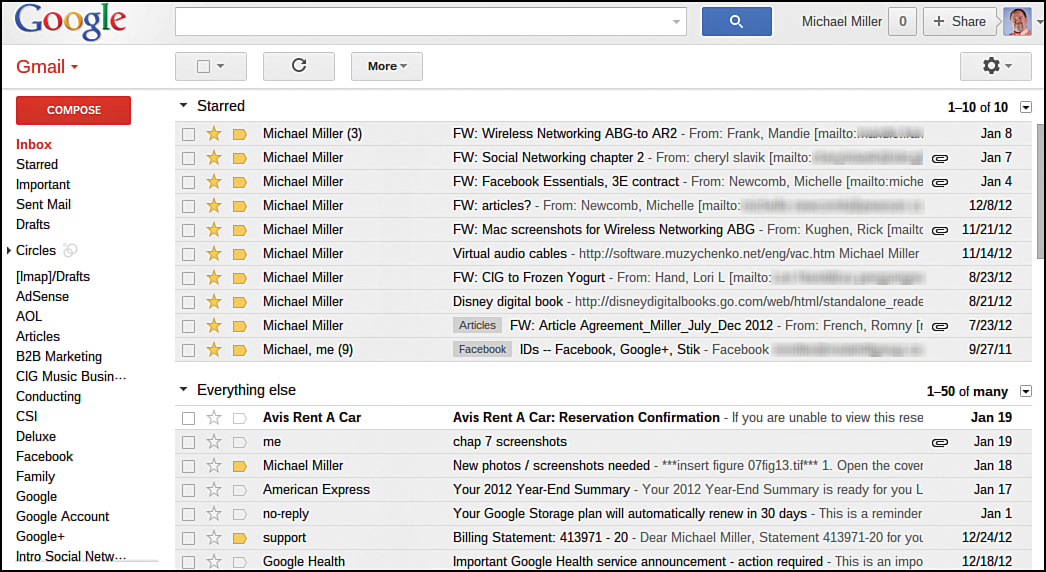
Also like the other services discussed in this chapter, Gmail is a free service; all you have to do is sign up for an account. Of course, if you already have a Google Account, that account can serve as your Gmail account. After you sign up for your Gmail account, you get assigned your email address (in the form of name@gmail.com) and you get access to the Gmail inbox page. And, of course, there’s quick access to Gmail from your Chromebook, using the Gmail app.
Outlook.com
Hotmail was one of the first web-based email services, and it’s still one of the largest. But it’s not called “Hotmail” anymore; Microsoft has spruced it up, added new functionality, and renamed it as Outlook.com (www.outlook.com).
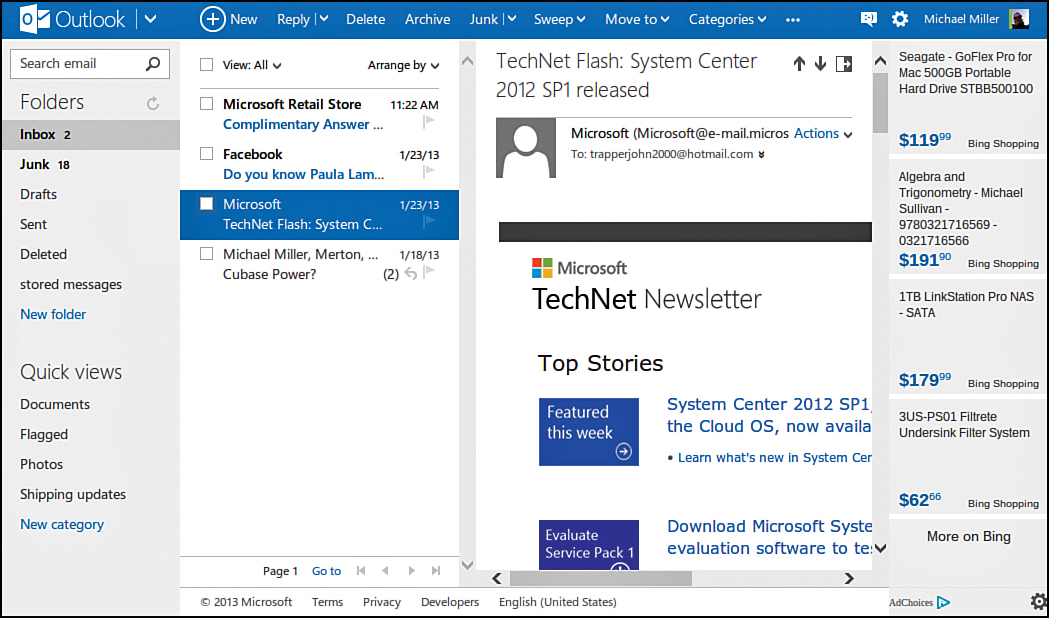
Like most web mail services, Outlook.com can be accessed from your Chromebook or any PC with a web browser and Internet connection. It’s free to use.
Yahoo! Mail
Yahoo! Mail (mail.yahoo.com) is another web mail service, provided by the popular Yahoo! search site. The basic Yahoo! Mail is free, although Yahoo! also offers a paid service, Yahoo! Mail Plus, that lets you send larger messages if you like. The free version is fine for most users.

Yahoo! Mail gives you unlimited storage—which means you can effectively use Yahoo! Mail as an online backup or file storage system. All you have to do is email yourself those files you want to store and then place those messages (with attachments) in your designated storage folder.

